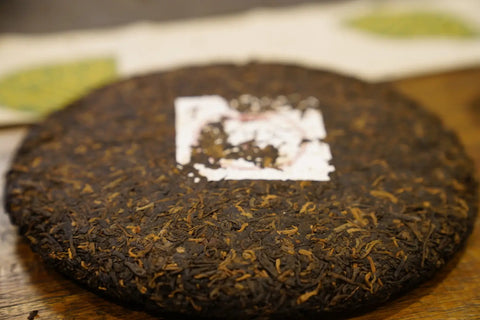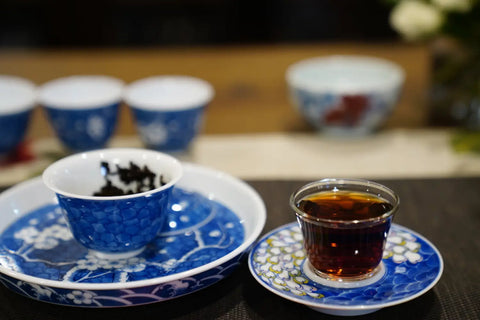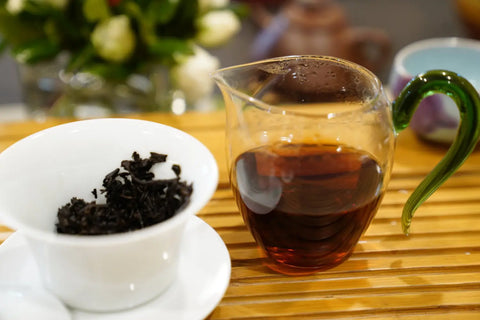
The Five Criteria for Discerning Shu Puerh Quality and Taste
Shu puerh is a fermented tea, which is accomplished through human intervention. While sheng puerh fermentation is achieved naturally and slowly during aging and storage, shu puerh is fermented quickly for expedited consumption.
The quality of puerh tea in the marketplace varies wildly, especially for shu puerh, more so than any other type of tea, so it would be beneficial to exercise extra caution when purchasing shu puerh. Since there are many inferior shu or fake aged shu puerhs on the market, it is critical for one to be more knowledgeable to be able to discern the quality of shu puerh. Yes, it would be helpful to get the tea from a reliable source, but I would not just look at the wrapper, the brand name, the vintage year, or who gives it to you.
The simple and most important way to know if it is a good quality shu puerh that you can safely drink and enjoy, is to brew and taste it for yourself. Of course, if you are inexperienced in shu puerh, use common sense, and be sure to buy from a trustworthy vendor. Our palate knows what we like, just as our five senses tell us what gourmet food should taste like. The same applies to any tea. Also, experience matters. The more tea you drink, the more knowledge you will attain for discerning good tea from bad.

The health benefits of shu puerh are well-known, including weight control, lowering high blood pressure, high blood sugar, high cholesterol, and improving digestion. However, a poor quality shu puerh will likely not offer any meaningful benefits and may even negatively impact your health.
So, how do we assess shu Puerh quality?
For a practical and easier application, we can use these five attributes of taste to judge the quality of a shu puerh: aromatically pleasant, cleanliness, purity, smoothness, and sweetness.
- Aromatically pleasant: Use your nose. The majority of shu’s aroma has “Chen Xiang”, meaning an aged aroma. It is the result of the post fermentation process and aging, and should result in a gentle and pleasant aroma, not a pungent, moldy or musty odor that offends the nose. You may describe some of the aromas as woody, lotus leaf, dates, etc. Vintage shu puerh may also exhibit other aromas like ginseng or camphor. It is a misconception that shu puerh tastes musty or like a forest floor. If the tea smells like that, it is an indication of an inferior tea, and I would not drink it. These poor-smelling shu puerhs (some even with sour taste), are more associated with poorly stored aged tea, and most being fabricated and manipulated to have the appearance of an aged tea.
- Clear and clean liquor: Visually examine the liquor, ideally from a clear vessel. Good shu puerh should have a clear, reddish-brown or dark red liquor. If the color is not clear, very dark, even black, this tells us that the tea is not clean. We can also observe the cleanliness of the liquor. A good rule of thumb is that a clean tea is transparent, and generally just tastes and feels better.
- Look for purity: A lot of inferior shu puerh has cloudiness or even tiny floating particles in the liquor, which is mainly either due to poor execution in the post-fermentation process or from low quality Maocha. We can also judge the purity by tasting the tea. A pure tea’s taste should always reflect its original form, without any other substances or flavors mixed in. Don’t underestimate your palate, it can detect impurities. If you are not sure about how purity should be exhibited in the tea, think about the difference between spring water and tap water, or your experience in drinking milk or other pure fruit juices.

- Smoothness: This one might be tricky. Do we like smoothies? How about ice cream? We know that tea is very smooth when the liquor flows easily through your mouth. It is gentle, like melting into your mouth, rolling down like silk, with no obstruction in your passageways. The tea’s short journey from mouth to your stomach is comfortable and warm, perhaps like an inner gentle massage? 😊 Your throat should not feel like something is lingering there, which is not uncommon in an inferior shu puerh tea. When we drink milk, we don’t feel any remnants in our throat, right? A good tea should have the same effect.
- Sweetness: Sweetness is very often applied to other types of tea, but most puerh drinkers may not be aware, and a few tea experts point out that sweetness in shu puerh is a very solid indicator of a quality shu puerh. Because shu puerh undergoes a fermentation process and the components broken down naturally in the process, so the sweetness in the shu puerh is more profound, at least it should not taste as bitter as the sheng puerhs do. A great shu puerh tea will possess sweetness even from the beginning and lasting to the very end. Even when the bulk of the tea flavor has faded, the water still tastes naturally sweet, like sweet water from the mountains. So, what about sweet after taste? Yes, it is a great quality indicator for any types of tea, including shu puerh. In Chinese tea community, we call it ”回甘“. Please note, this attribute is a great indicator, but not a must-have. This character is well demonstrated in our Vintage 2004 Bliss Shu puerh, with great sweet after taste as well. Our 1973 Formula Qizi Bing Cha Shu puerh is also a good example. We strongly suggest that you gave them a try.

These five tasting aspects are truly valuable and crucial for judging and tasting your shu puerh tea. Victoria derived these five criteria based on her years of experience, involving a lot of trial and error, tea sourcing trips and tasting. And by that, we mean a lot of drinking and tasting. Please note, the five aspects are best considered in entirety when judging the tea. In a particular tea, some characteristics are more noticeable than other aspects, but for a great shu puerh, they work together to display an amazing quality and a thoroughly enjoyable drinking session.
Finding a great shu puerh is quite a bit more difficult than finding a great sheng, and as our standards are high for shu puerh, our selection of shu puerh tea is relatively small. We only offer tea that we enjoy drinking ourselves.
Here, for the benefits of our tea community and tea friends, as an FYI, please beware of puerh tea market shenanigans, especially vintage puerh tea, as the dissemination of misleading and misrepresent fake vintage teas as the real thing. Now that you are armed with these five criteria, you are well on your way to your healthy and tasty Shu experience! In the next blog, we will talk about “Essentials and Tricks for Brewing a Great Cup of Puerh”. If you have any questions or like what you read, please comment below or share.
